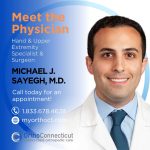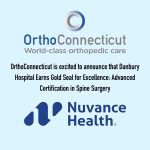When your knee goes POP: OrthoConnecticut Talks ACL Injury
From Hamlet Hub
“POP” – You Tore Your ACL! Now what?

Imagine this … you’re out for a walk, or playing sports, and quickly pivot changing direction, maybe misstep or fall and hit your knee – and then you feel or hear a popping sound.
It’s likely you tore or sprained your ACL (anterior cruciate ligament). It’s a very common injury, especially in females, because the ACL is the major stabilizing ligament of the knee connecting the femur (thighbone) to the tibia (shin).
Here are a few common symptoms of an ACL tear or sprain.
- Popping sound or feel, often when pivoting direction
- Pain – no pain – both are possible symptoms. Did you know that the ACL ligament has no nerves ending at it? Counterintuitively, a partial ACL tear that has ligament tension may have severe pain, whereas a full ACL tear with no ligament tension may not hurt.
- Rapid and acute knee swelling
- Stiff knee and reduced range of motion
- Feeling of instability when bearing weight, and maybe a grinding sensation
Next steps?
- Ice
- Compress
- Elevate swollen knee
- See a doctor!
Don’t wait to be evaluated. With an ACL injury, it’s important to be examined by a skilled, board-certified Sports Medicine Specialist, who is also an Orthopedic Surgeon. Due to lack of blood supply to the ligament, a torn ACL cannot heal on its own. An ACL injury may also require surgery whereas a sprained (or stretched) ACL ligament may have additional healing options and protocols.
During your visit, an Orthopedist will compare your knees, review your symptoms, and manually test the integrity and stability of the ACL. To confirm diagnosis, an x-ray will be taken, but also an ultrasound and/or MRI may be needed to check for additional injury to bone, cartilage or menisci. Should your injury occurs after hours, go to an Orthopedic Urgent Care walk in center, such as OrthoCare Express, staffed by experienced Orthopedic professionals.
You’ve been diagnosed: 3 Approaches to Consider
Treatment recommendations depend on patient need, age, activity level, general health, and assessed stability of the knee. The goal is to get patients properly walking again.
Nonsurgical options. Good for ACL sprains and smaller ACL tears, depending on lifestyle. These could include a brace to stabilize the knee, physical rehabilitation, and pain relief advice. Consider this if you don’t participate in knee-straining sports, are less active, or want to wait-and-see if you can avoid surgery.
Surgery. Often advised earlier for younger, physically active, and elite athlete patients with a complete (or partial) ACL tear, and additional knee damage. ACL reconstruction involves replacing or repairing the ACL, followed by physical rehabilitation, and can take up to a year to fully recover. An additional benefit is it can also help avoid or delay osteoarthritic complications arising from additional meniscus or cartilage damage that may occur over time.
Age is not the determining factor in ACL surgery anymore. Active people in their 40s, 50s, and beyond, with minimal arthritis, are having ACL reconstruction because of improved surgical techniques and increased activity during aging. ACL surgery will not be helpful if you have extensive arthritis.
Wait-and-see approach. If your specialist recommends a wait-and-see approach instead of early surgery, a scientific study published in The New England Journal of Medicine backs that up. After following 121 young, active adults randomized to surgical or nonsurgical treatments and followed for two years, they concluded nonsurgical treatment with rehab substantially reduced frequency of surgical reconstructions.
OrthoConnecticut Can Help
OrthoConnecticut is the region’s leading orthopedic practice. Our physicians and physician assistants are available to help if you’ve injured your ACL. We will help you understand all your options to you get moving again. Contact us today for an appointment and #getmovingCT.














